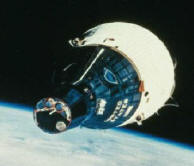NASA needs to get back to launching astronauts in capsules as soon as possible. So said a member of the American Congress who called for the production of cheap and safe alternatives to winged spaceships of the shuttle's type
 NASA needs to get back to launching astronauts in capsules as soon as possible. So said a member of the American Congress who called for the production of cheap and safe alternatives to winged spaceships of the shuttle's type.
NASA needs to get back to launching astronauts in capsules as soon as possible. So said a member of the American Congress who called for the production of cheap and safe alternatives to winged spaceships of the shuttle's type.
"I predict that in the end they will choose a design with ballistic capsules," said House of Representatives member Dave Weldon, a Republican who is a member of several committees relevant to the field of space and represents districts in Florida that also include Cape Canaveral, the US spaceport.
In laying out his space vision, President Bush said that NASA should retire the shuttle fleet by 2010, with the completion of the International Space Station. This will be the first step in a decade-long journey to Mars.
Bush's plan puts a four-year gap between the end of the shuttle program and the test of a new lunar rover in 2014. The plan also did not say how astronauts would get on and off the space station after 2010, or how they would be able to evacuate in an emergency.
"From the economic point of view, it makes sense to produce a vehicle that will continue the support of the station, but will also be flexible to fly to the moon." Weldon said.
"You don't need wings and landing gear if you're going to the moon. clear and smooth. It only adds unnecessary weight and potential for failure," says Weldon.
Many observers expected Bush to call for replacing the shuttles with Apollo-like capsules. When Bush did not mention those capsules, and NASA Administrator Sean O'Keefe later said that the agency must "keep an open mind" in planning, they left many wondering whether internal debate at NASA was derailing the plan."
"Although the president did not go into details, but if you read between the lines, you will see that this is the type of tool we will end up with." said. Over the years, NASA has had three models to produce a replacement for the shuttles. All three involved winged spacecraft and all were disqualified before they even reached the stage of test flights.
In its criticism of NASA's management, the Commission of Inquiry into the Columbia disaster determined to halt the development of the new spacecraft until a mission was assigned to them. Most aeronautical engineers agree that winged spacecraft have very little value outside of low Earth orbit, where the shuttles have served as the sole role of the US manned program for over twenty years.
Proponents of the capsules say that much less research and development would be needed. "We know the science and engineering of all of these," Weldon says. "It worked in the XNUMXs, XNUMXs and XNUMXs. It is not necessary to invest billions of dollars to learn engineering."
